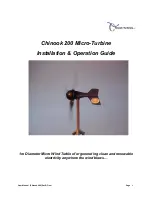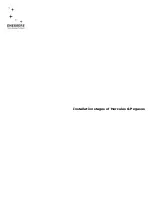
Chinook 200 Nominal
Output Voltage
DC Fuse / DC Circuit Breaker Rating
12V
25 Amp
24V
13 Amp
•
Run / Stop Switch -
A simple switch arrangement can provide a safe and easy way of stopping
the turbine during high winds or for maintenance. A ‘SPDT’ (single pole double throw) switch is
best for this purpose. As the switch is thrown, the batteries are disconnected and the turbine is
‘shorted’ reducing the rotor to a slow rotation. Refer to the generic wiring diagram.
•
Charge Controller -
The
Chinook 200
diversion charge controller is used to manage the power
output from the turbine to the batteries. A diversion charge controller operates by increasingly
switching output to a dump load once the batteries begin to reach high voltages. The dump load
consumes the ‘excess’ power from the turbine. This means that the turbine’s power output is al-
ways utilized whether the batteries are fully charged or not. Depending on the size of the dump
load, the turbine may slow down or stall during a period when the power is being diverted. Larger
capacity battery banks will be able to store more energy and so the dump load will be used less.
•
‘Hybrid’ Systems -
The
Chinook 200
turbine can be used in parallel with PV panels. We recom-
mend that the PV panels are wired independently with a separate charge controller specifically
designed for use with PV panels, and connected in parallel with the battery bank. The Chinook
200 controller can be used with PV Panels as long as the Maximum rated panel output does not
exceed
75 Watts
when using the turbine’s dump controller.
User Manual (Chinook 200) Rev D Final Page 14
Содержание 200
Страница 15: ...3 User Manual Chinook 200 Rev D Final Page 15 ...




















